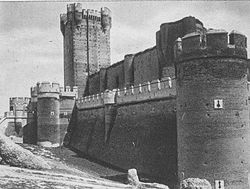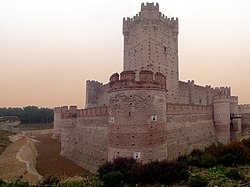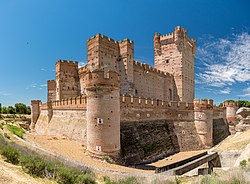|
Castle of La Mota
The Castle of La Mota or Castillo de La Mota is a medieval fortress in the town of Medina del Campo, province of Valladolid, Spain. It is so named because of its location on an elevated hill, a mota (in Spanish), from where it dominates the town and surrounding land. The adjacent town came to be surrounded by an expanding series of walls in subsequent years, of which little remains. It has been protected by the state since 1904, first as a national monument and more recently as a site of cultural interest, or Bien de Interés Cultural.[1] OverviewThe castle's main feature is the large outer barbican. The interior castle has a trapezoidal plan, with 4 towers and a square yard. It has a large square keep and an inner curtain wall, which was used for archers. Access to the castle was originally over a drawbridge. It is made from local red brick, stone being used only for some details. History    Initial fortification of the village, repopulated after Moorish depredations, led to the creation of a fortress on the site, starting in 1080. The village soon grew alongside. In 1354 Henry of Trastamara is known to have taken the fortress by force. In 1390 King John I of Castile granted the town to his son, the infante Ferdinand of Antequera, future king of Aragon. After the latter's death in 1416, his son, John II of Aragon, in 1433 taxed local residents to help the construction at the Mota. During the following century the castle and town changed hands between the rival kings of Castile and Aragon, with the castle and town being sometimes held by opposing sides. In 1439, for example, the prince of Aragon locked the town gates, thereby imprisoning the Castilian king within the castle walls. In 1441 the Castilian king was able to obtain the surrender of some 250 soldiers of Aragon within the castle. After the First Battle of Olmedo in 1445 the castle came once and for all into hands of the Castilian monarchy. In 1460 King Henry IV of Castile built the central tower. In 1464, Henry gave the castle to the Archbishop of Toledo, Alonso Carrillo, who soon betrayed the king and backed the rival claimant Afonso V of Portugal. After the castle had been taken by force it fell by 1467 into the hands of supporters of King Afonso, whilst the village supported Henry. Subsequently the castle was disputed between the princess claimant, Isabella of Castile, and her cousin of dubious paternity, the princess Juana la Beltraneja. After a succession of owners, in 1475 the crown of Castile reclaimed the castle and built an artillery bastion, on the entrance of which are the heraldic symbols of the Catholic Monarchs, Ferdinand and Isabella.  The castle became a prominent prison and variously housed Hernando Pizarro,[2]: 143 Rodrigo Calderón, Duke Ferdinand of Calabria and Cesare Borgia, among others. The last of them is known for having escaped from the nearly 40-metre-high tower by climbing down a rope. In 1939, with the end of Spanish Civil War, dictator Franco lent the castle to Sección Femenina ("Female Section") of FET y de las JONS as its headquarters. Restoration works were undertaken between 1939 and 1942. On 29 May 1942, it took place the delivery ceremony of the castle to the Female Section's Senior Command School. The official act, with more than 10,000 attendees, was presided over by Generalísimo Franco accompanied by personalities like José Ibáñez Martín, Pedro Laín Entralgo, José Luis de Arrese, Ramón Serrano Suñer or Dionisio Ridruejo. Franco's speech praised Isabella I of Castile's policy as a "totalitarian and racist revolution, in the end, for being Catholic", and condemned Second Spanish Republic's liberal policies. Senior Command School would finally be closed in January 1977.[3] References
Sources
External linksWikimedia Commons has media related to Castillo de la Mota. |
||||||||||||||||||||||||||||
